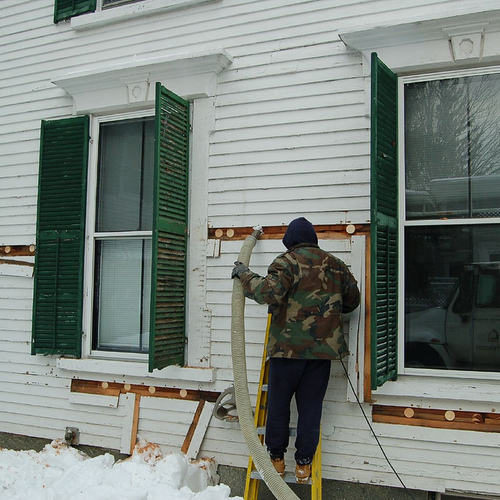
Image Credit: iStock
Residential PACE (property assessed clean energy), an innovative solution for financing energy efficiency and renewable energy projects, is being led by a set of industry mavens seeking to realize the promise of this public–private partnership. Specifically, industry stakeholders have come together to create a set of consumer protection standards that ensure that homeowners reap the full benefits of PACE while safeguarding against predatory behavior in this nascent market.
The U.S. Department of Energy (DOE) has recently published new program guidelines that further codify such standards. The path to these policies, and the risks they mitigate, are outlined in Rocky Mountain Institute’s new insight brief, Driving Growth and Mitigating Risk: Standards for Residential PACE Programs.
Why PACE?
PACE helps homeowners overcome two major barriers to financing home energy performance improvement: first, the availability of up-front capital to pay for efficiency measures (such as lighting, HVAC upgrades, or the installation of a photovoltaic system); and second, the uncertainty of payback on such measures (given that the average U.S. homeowner owns their home for 15 years, according to the U.S. Federal Reserve).
In states with active residential PACE programs, homeowners can finance 100% of project costs. Loans are repaid for up to 20 years by means of an assessment added to the property tax bill, meaning that PACE financing stays with the building upon sale and can be transferred from one owner to the next. Some PACE providers offer financing for up to 30 years, constrained by the expectant life span of financed projects.
Since the DOE’s issuance of the “Guidelines for Pilot PACE Financing Programs” in 2010, 31 states have passed PACE-enabling legislation, and the number of states with active PACE programs (commercial and residential) has grown to 16 (as of July 2016).
PACE and the need for consumer protection
As the market for PACE financing grows, the local governments that authorize it and the private companies that typically provide it are focused on protecting consumers, who most often learn about PACE from an HVAC, roofing, window, solar, or other installer of PACE-eligible measures.
“We continue to hear concerns about whether or not homeowners will get in over their heads with PACE loans — similar to how they can with a credit card,” said Martha Campbell, a manager with Rocky Mountain Institute’s Buildings program. “What consumer protections do is prevent homeowners from over-leveraging their property, and help ensure that the homeowner will be able to make the additional payments without putting their commitments to their other financial obligations at risk.”
Because PACE projects can be such a substantial commitment for homeowners, it’s incumbent on all parties involved in a PACE-funded project to follow the highest standards of consumer protection to ensure the best outcomes. This is especially true because PACE impacts local governments that sponsor programs, homeowners, and — in most cases — an existing mortgage lender.
Putting protections in place
With the continued momentum and expansion of PACE, parties at the state and national levels have taken the initiative to set and implement best-in-class consumer protection guidelines. The DOE’s “Guidelines for Pilot PACE Financing Programs” served as the basis for early best practices established in 2014 by PACENation, an organization focused on promoting PACE by providing leadership and support to a growing member base (then operating as PACENow).
In August 2015, President Obama committed the U.S. Department of Housing and Urban Development’s Federal Housing Administration (HUD/FHA) and the Department of Veterans Affairs (VA) to provide guidance on critical design elements for residential PACE programs. The FHA released its Mortgagee Letter in July 2016, which sent a strong message that helps solidify the nature of PACE liens in relation to first mortgages — a contentious issue that had impeded broader adoption and scaling of residential PACE across the country.
PACENation, in collaboration with industry leaders, developed and released Consumer Protection Policies Version 1.0 earlier this year. The policies were adopted by the California Statewide Communities Development Authority and the Western Riverside Council of Governments — both of which heavily informed California’s PACE policies — and now serve as an industry standard.
“The industry needs to be aware that consumer protection standards that work already exist,” said Campbell. “More and more states will consider residential PACE thanks to increased DOE support and new Federal Housing Administration guidelines, which can benefit from clarity around what risks these standards can mitigate in the market. Driving consensus on best-in-class guidelines can improve confidence and inject more capital into programs.”
Today, more consistent consumer protection standards upheld across local communities and states will help ensure the successful growth and scaling of residential PACE programs, while protecting the integrity of PACE as a public–private partnership. Standardization of operations across jurisdictional boundaries will reduce the need for customization and enable consistency, which will allow PACE programs to continue to streamline their operations, and thus provide lower costs to participating homeowners.
RMI and PACENation’s newly published insight brief builds on past successes to detail a set of perceived risks around PACE, and how they can be managed through consumer protection policies.
“We applaud the efforts of PACE industry stakeholders in developing robust program guidelines and independent audit processes, and support the industry’s goal for these guidelines to be the standard across state and local governments,” said Campbell. “Thanks to early leaders, we have a toolkit that can enable the standardization and coordination necessary to enable PACE financing to gain traction nationally.”
Kelly Vaughn is the marketing manager at the Rocky Mountain Institute, where this blog was originally published.
Weekly Newsletter
Get building science and energy efficiency advice, plus special offers, in your inbox.















3 Comments
Wow !
I need to get into the business of funding/Administrating PACE loans because it's essentially risk free.
WSJ article on the "subprime crisis" brewing with PACE Loans
http://www.wsj.com/articles/americas-fastest-growing-loan-category-has-eerie-echoes-of-subprime-crisis-1484060984
Here's a link to the same article with no paywall
John,
The same article is available here (for anyone who doesn't happen to subscribe to the Wall Street Journal):
https://www.msn.com/en-us/news/other/loan-boom-echoes-subprime-crisis/ar-BBy7eg1
Log in or create an account to post a comment.
Sign up Log in